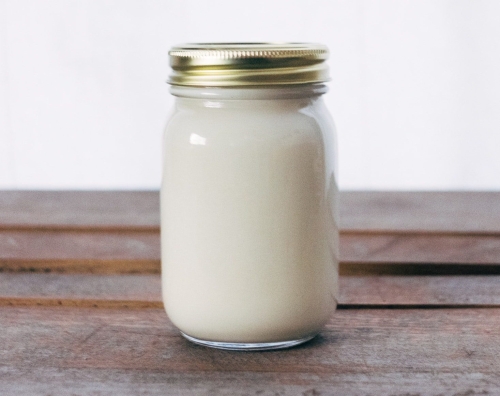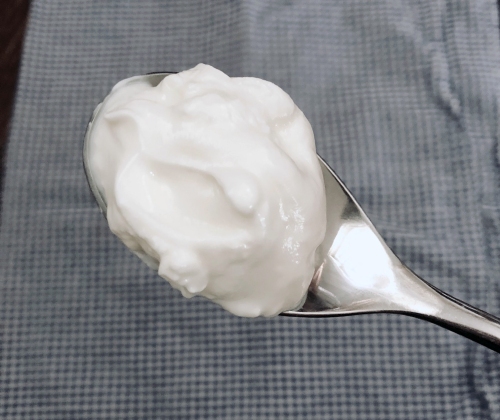
We bought our first tiny deep freezer secondhand. We have since been given a bigger one, and I don’t know what I would do without it.
Micro-stocking
I find it hard to relate to money-saving tips where people say, “If you find one of your staples on sale, stock up!” And then they proceed to show you how they dropped $50-$100 on all the extra pork chops they could ever need. I don’t know about you, but I don’t have that kind of “wiggle room” in my grocery budget.
If something is super cheap on sale, you may not be able to “stock up,” but pick up an extra one or two. For me, stocking up looks like buying one extra of something when it is on sale and tossing it into the freezer for later. While it would certainly be nice, I don’t have a massive amount of food stocked up in my freezer. I do have several meals’ worth, though, and that is so helpful. (I still dream of having a side of beef or pork or a pile of chickens stashed away for the year, but unfortunately I haven’t found a way to do that where it actually saves us money.)
If you’re making a pot of soup, make some extra and freeze it in a gallon-sized freezer bag. If you are tired of eating the pulled pork or taco beef you made a few days ago, put the rest in the freezer. Freeze that last raw chicken breast you didn’t use. (Bonus points if you marinate it first! More on that in a future post!) Freeze the extra loaf of bread you got on sale. Shredded cheese freezes great; if it freezes into a block, bang it on the floor or counter a few times to break it up. You can even freeze milk and butter. (But don’t freeze yogurt, because the texture gets weird.) If something is about to go bad, just freeze it!
Some years I can’t find any, but I try to buy turkey on sale after Thanksgiving or Christmas. I’ve bought large whole turkeys for $3-$6 EACH before. Roast it in the oven with some simple seasonings (you’re not going for Grandma’s famous brined showstopper here). When it has cooled, strip the meat from the bones and freeze meal-sized portions to be used in quick meals later, like when a recipe calls for chicken that is already cooked. Same with ham after Easter (Aldi is especially good about this). Cook it in the crockpot with a few seasonings, cut it into small cubes, and freeze in a freezer bag. Just pull out a handful or two whenever you need it!
Extra items
I’m not going to buy a whole carton of orange juice just because I need a few tablespoons for my recipe. I’m not going to go to the store for limes just because I needed to make some last-minute guacamole or cilantro-lime slaw. The freezer comes in so handy for flavoring your food without adding lots of items to your grocery list.
I keep a can of orange juice concentrate in the freezer. If I need orange juice for a recipe, I just scoop out a spoonful or two of orange juice concentrate and add a splash of water. The can keeps for a long time in the freezer, and I always have orange juice when I need it.
I also get a bunch of limes every now and then and zest and juice them all at once. This is both a money saver and a time saver. The zest lasts a really long time in the freezer, and you can just grab a pinch or two every time you need lime zest or want to add some lime flavor. I also freeze the lime juice in an ice tray then put the cubes in an airtight container in the freezer. Any time you need lime juice, just pull out however much you need. You can do this with oranges and lemons too.
I keep a bottle of lemon juice in the fridge at all times. I use it whenever I need lemon juice, but I also use it if I need lime juice and don’t have any actual lime juice in the freezer. This way I still get the acidic liquid of citrus juice, and then I toss in some lime zest for the lime flavor.
Most recipes require just a Tablespoon or two of tomato paste, so what do you do with the rest of the can? Spoon it into Tablespoon-ish sized blobs (you can measure, but I don’t) onto a sheet of waxed paper or tinfoil or some other nonstick surface and place it in the freezer. When the blobs have frozen, put them in an airtight container and pull them out as needed.
If you are not sure you will be able to use the rest of a sauce or something before it goes bad, freeze it in an ice cube tray and pop the cubes into a container for the freezer. (If you’re feeling especially lazy/efficient, you can just pour the sauce/paste straight into a zipper bag, lay it flat so it freezes into a thin sheet, then break off pieces as you need them.)
Make it to last
I often make staples and freeze them so we can enjoy them for longer.
I really want to learn how to can, but until then, the freezer has come to my rescue. I buy lots of apples in the fall when they are cheap and in season, and I make tons of our favorite homemade apple butter. I put it in mason jars and freeze them so we can eat apple butter all year. This is actually the first time in YEARS that I didn’t make apple butter (I simply could not cram it into my schedule this Fall, and I missed my window for super-cheap apple prices). We are bummed, but surely we can adjust to buying store-jam for the year, right? …Right?
There is a way to make homemade chicken stock or broth where it is cheap; there is also a way to make it where it is almost free. I use a lot of chicken stock, and I have paid almost nothing for it for years.
Any time our family eats chicken or turkey, we save the bones, even if it is a roast chicken from the grocery store. Occasionally I have raw chicken bones too, but usually they are already cooked. The only time I won’t save bones is if they were cooked with a flavor I really don’t think would work in a broth. I store them in a gallon-size freezer bag that stays in the freezer (I reuse the bag over and over). Whenever the bag starts to get about halfway full, I make chicken stock.
I also save vegetable scraps in a quart-size zipper bag that also stays in the freezer and gets reused. Carrot peels and ends, onion skin and ends, garlic skin, zucchini ends, and celery ends are the main ones I save (some vegetables won’t work well for broth).
I dump the bones into the slow cooker along with the vegetable scraps. I fill the crockpot the rest of the way with water, turn on high, and leave it on about 12 hours (I’ve done it for 8 hours, I’ve done it for 24 hours; the length of time is really flexible). Let it cool in the crockpot for several more hours. Take out the big stuff and throw it away, then run the liquid through a mesh strainer to strain the rest of the scraps out. I have some plastic containers that I use for chicken broth, and I measure two cups of broth into each container (most recipes call for chicken broth in two-cup increments). For the cost of water and the electricity to run the crockpot, I now have around 20 cups of chicken stock for the freezer.
Believe it or not, I’m not a huge fan of most “freezer meals” or “crockpot freezer meals,” and I’ll get into that later. I am still open to being convinced otherwise! There are a few I do like. I am, however, a strong proponent of using the freezer to make mealtime easier — especially breakfast. I have so much more to say about freezer strategy for saving money on groceries, but I will get to that in future posts.
Do any of these freezer hacks surprise you? Which ones sound most useful for you?
Other posts in the Stretch Your Grocery Budget series:
- Part 1: Introduction
- Part 2: Meal Planning
- Part 3: Dairy
- Part 4: Breakfast
- Part 5: Freeze It




